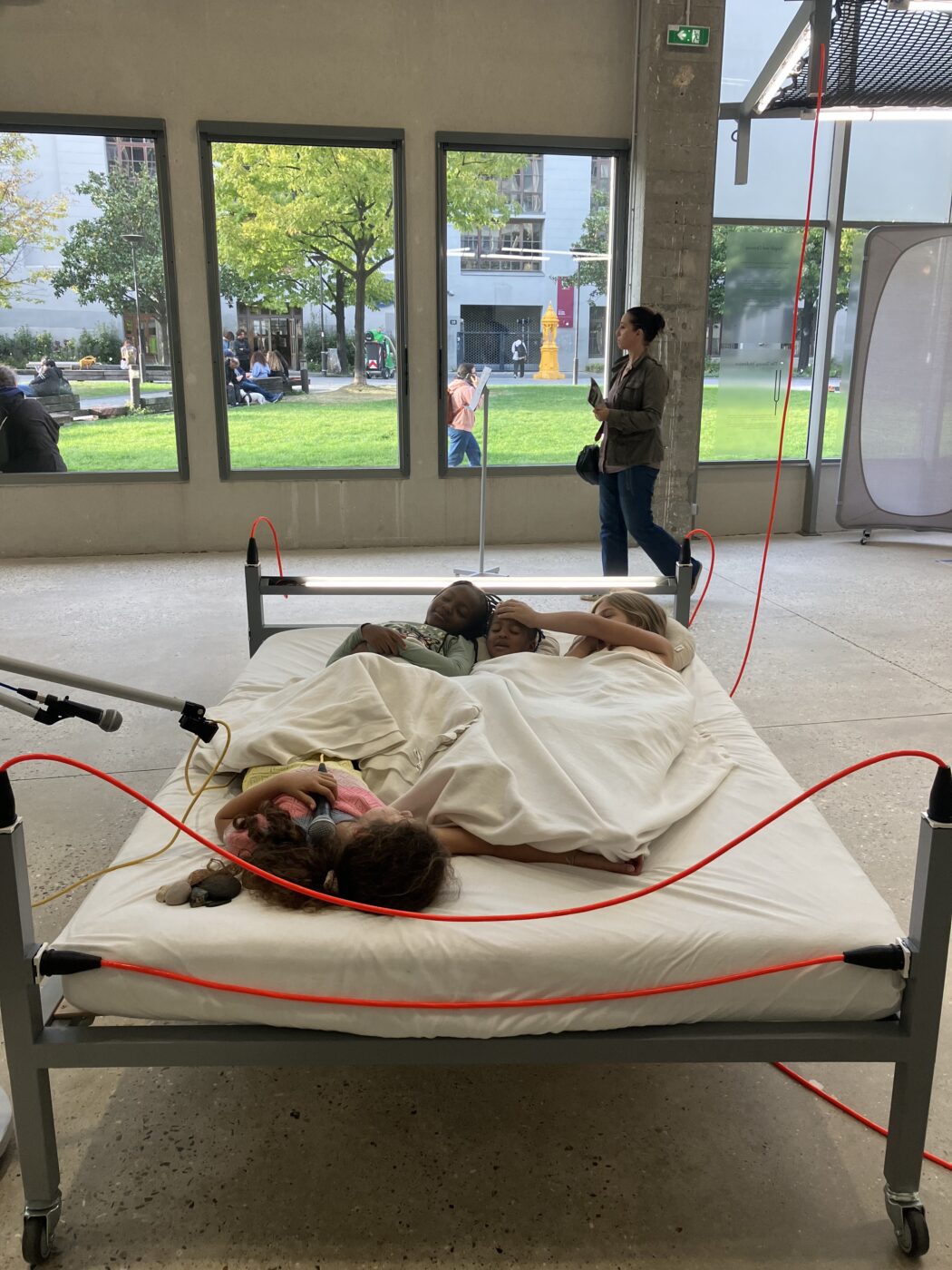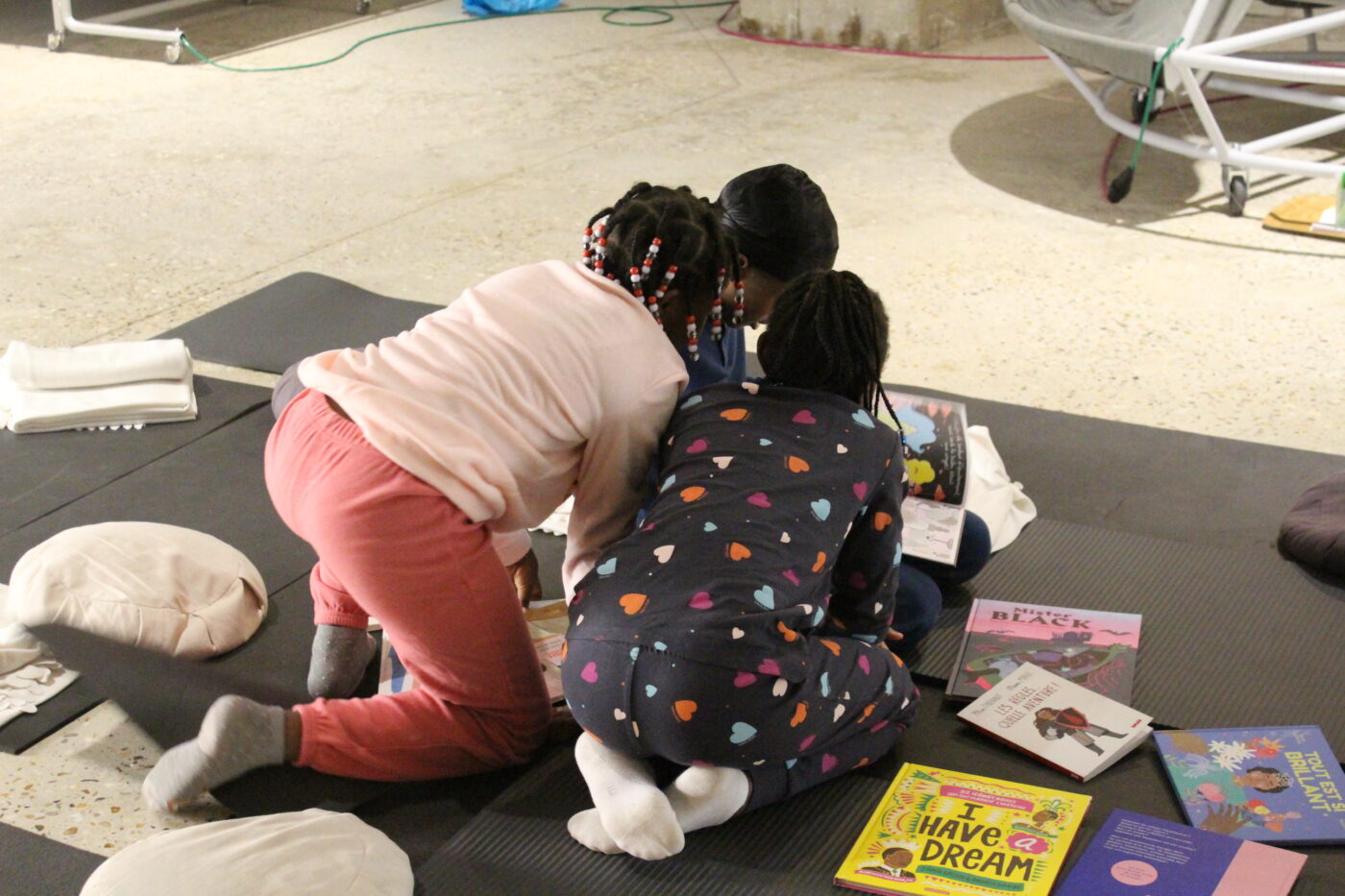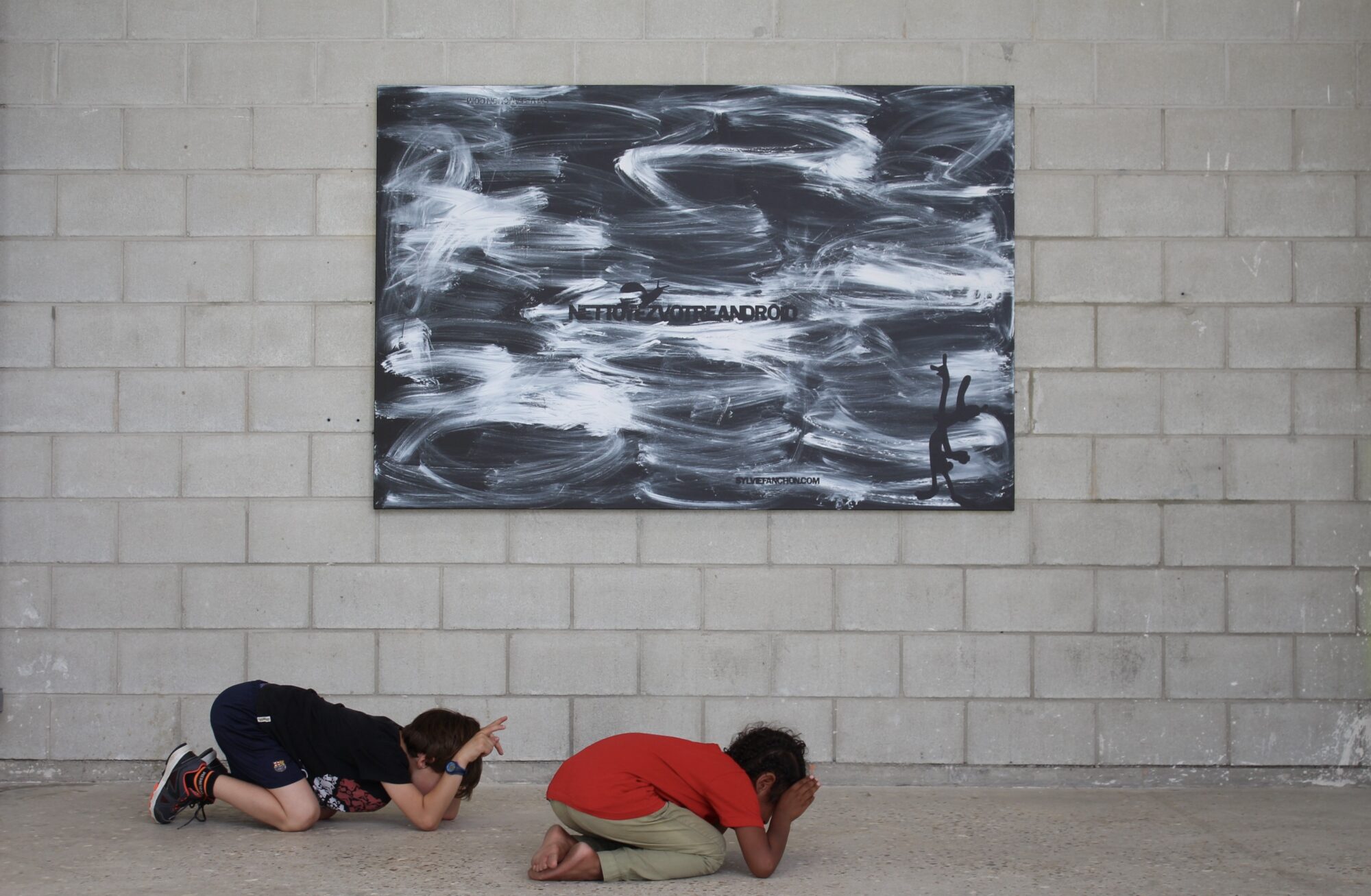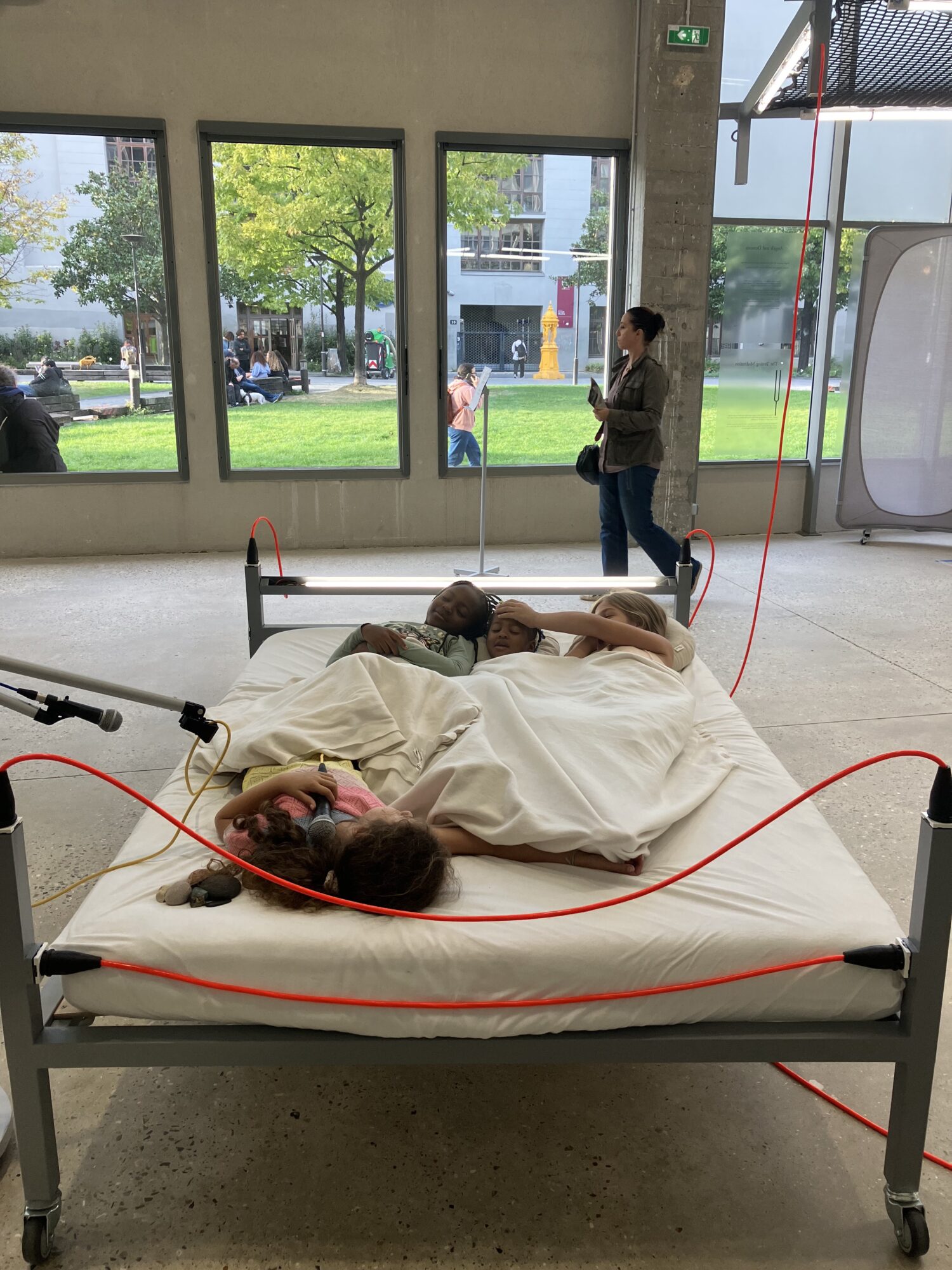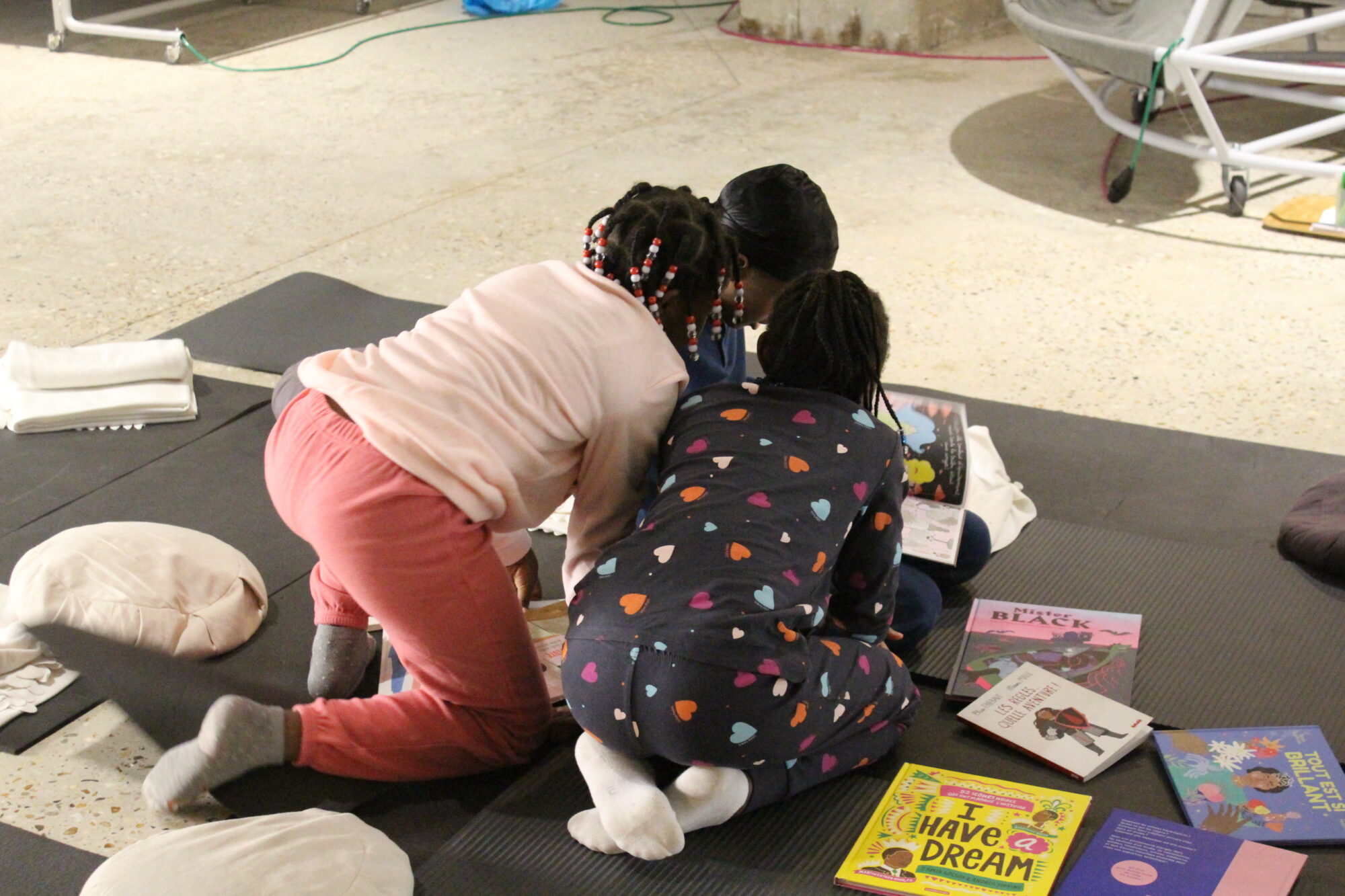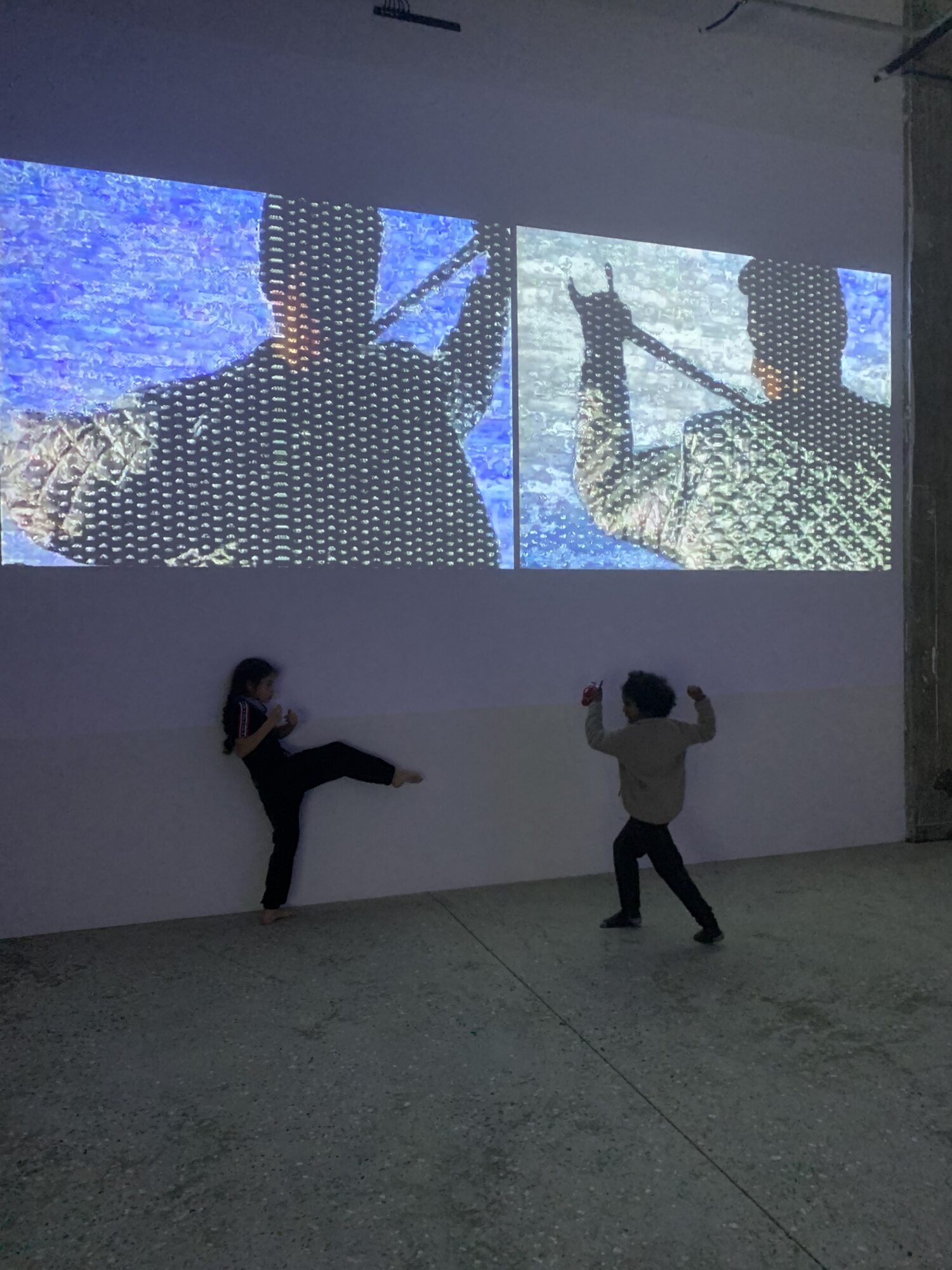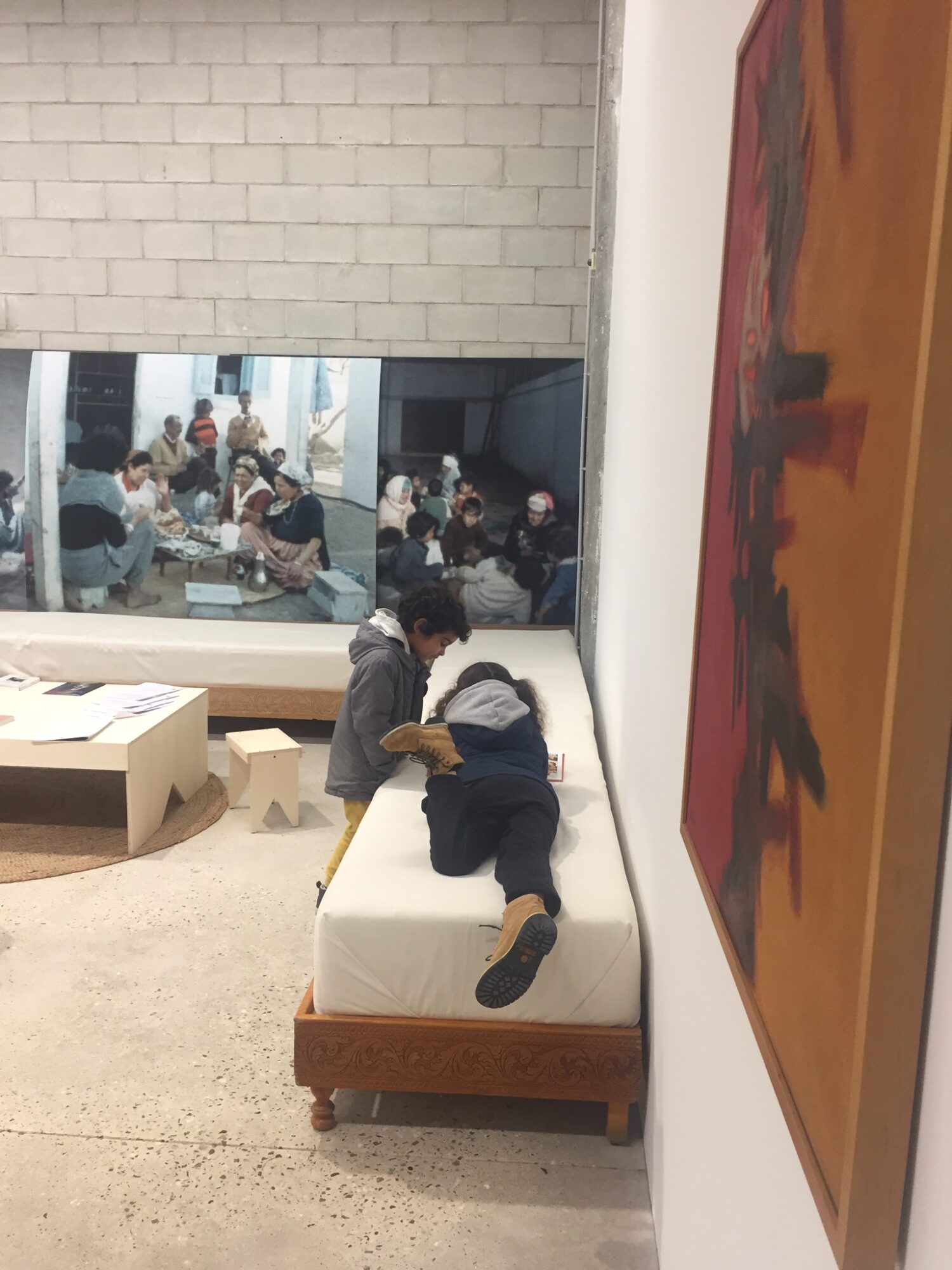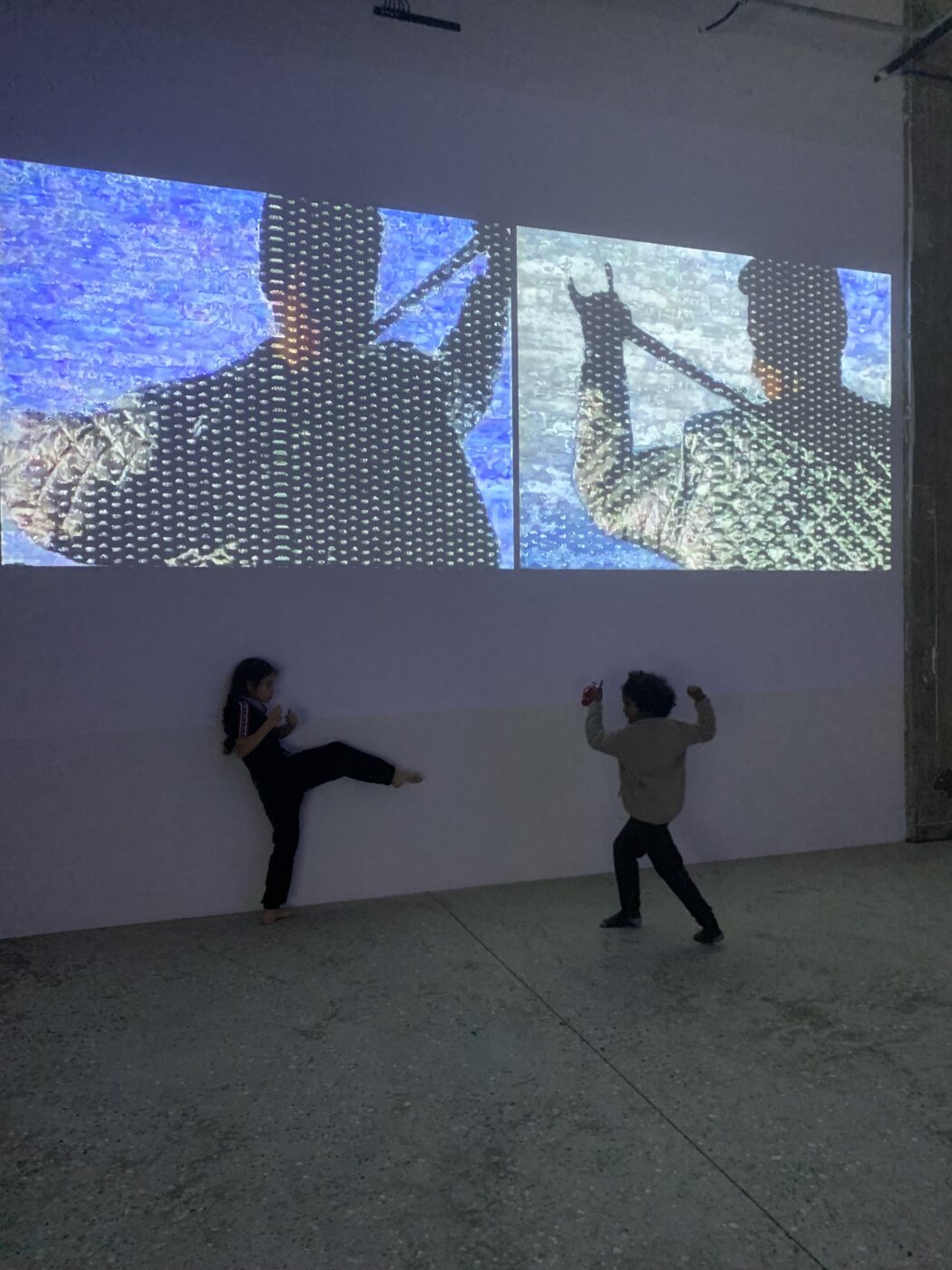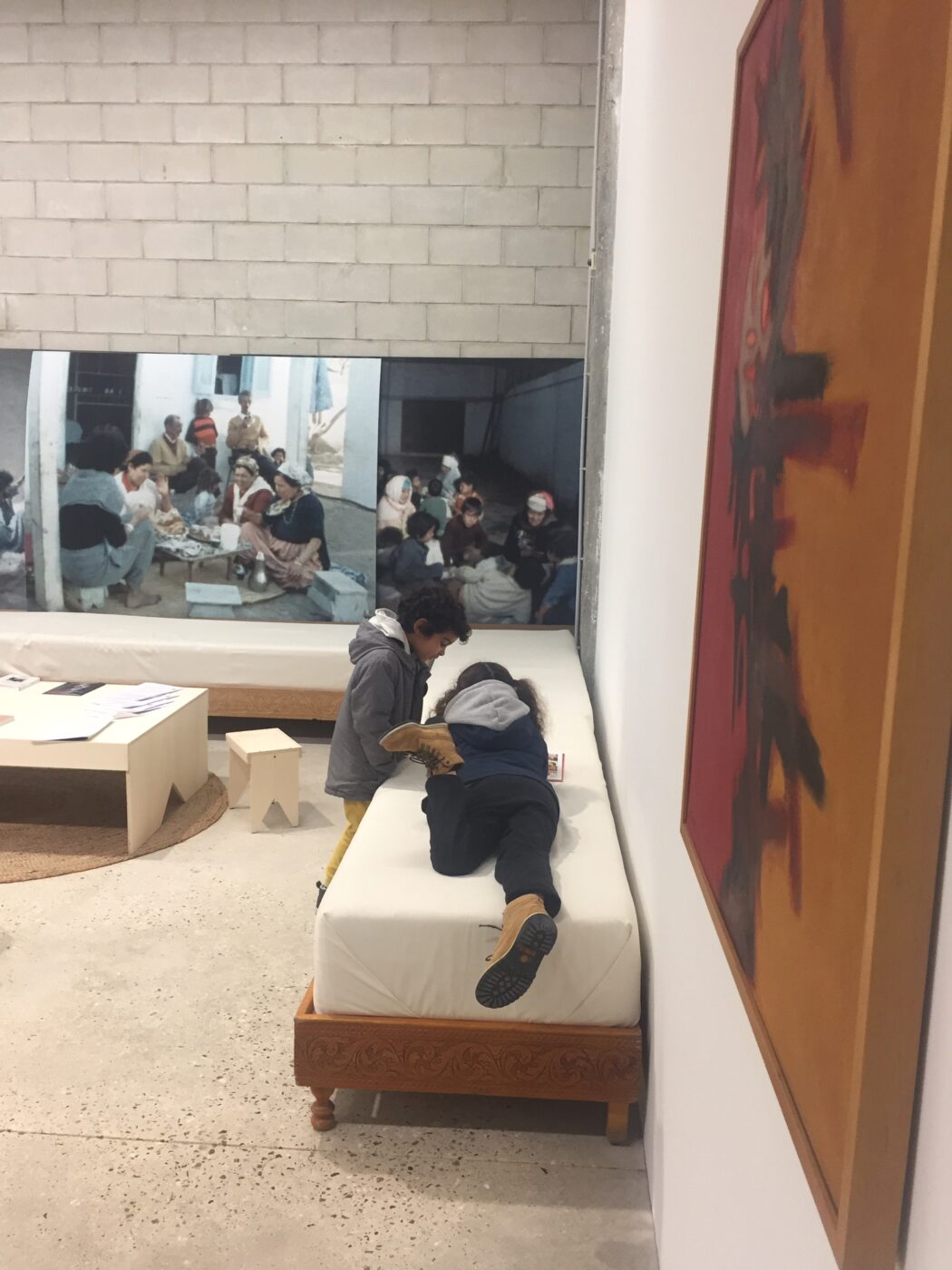Improvised workshop in contact with works by Sylvie Fanchon in the exhibition “SOFARSOGOOD”, Paris, 2024. © Susie Richard.
Whether coming to chat, read, play or simply shelter from the cold or rain, a small assembly of children gathers at Bétonsalon after school. Sometimes playful, teeming with ideas, games or mischief, sometimes overcome by boredom or exhaustion after a long day, sometimes bringing along a snack so they can stay for as long as possible and other times in and out in a flash, these art centre regulars inhabit the exhibition space all year round.
Aged between 4 and 12, they come and go, dropping by time and again – commenting on the artworks discovered and rediscovered over weeks, acting as guides for visitors or for their parents who are shier about crossing the threshold of the art centre’s doors. It was in their company that the project “l’Assemblée des enfants” (The Assembly of children) took form: an experimental, spontaneous, self-reflective space for public outreach, shaped according to the children’s desires as well as suggestions from Bétonsalon’s public outreach team.
As the months went by, our initial encounter with the children gave way to a period of mutual adjustment until finally a familiar and friendly understanding was reached. As the months went by, the daily inflow of these children raised questions for us and this first-hand experience led to reflections about the long-term future. Observing them proves to be as fascinating as it is informative. Transgressing expectations of more or less normative behaviour, they transform the conventional uses of the exhibition space: in what way will they bring freedom, disorder and escapism into the art centre? How should we respond to them, welcome them? How can we do and undo our mediation work alongside them? What effect will this improvised, but intentional, partnership have on the institution over the long term? “The Assembly of children” doesn’t (really) answer these questions, but, better still, never stops asking new ones, opening up countless avenues of exploration, from and about childhood.
“If there are his school photos up, could we put some of me up too?”
Sacha⁴, aged 9, talking about the archives presented in the exhibition “Jean-Noël Herlin, a junk mail junkie” – January/April 2024
A simple comparison demonstrates how childhood is represented in art both today and in the past. The sacred Virgin and child of the Middle Ages; the sovereign king
children or angelic cupids of the Renaissance; the happy, homely and rural childhood of the Impressionists; the urban and inspiring childhood of outsider art, and so on: there is certainly no shortage of examples of the treatment of childhood as an artistic subject, in art both today and in the past. Yet, are children subjects and actors in the production of these images? Whether portraying childhood in its innocence or vulnerability or, on the contrary, as a period of precociousness or rebellion, the iconography of childhood carries with it narratives, banalities and fantasies. We see children, but do we hear their voices? The artist and filmmaker Ane Hjort Guttu describes her experience of such an endeavour after co-curating an exhibition with her seven-year-old son, Einar. The pair worked together on everything from the artistic direction to the organisation of the opening night, from the choice of artworks to the scenography⁵. At Bétonsalon, through their suggestions for changes here and there – to add one of their own pieces of artwork, to modify a work so that it represents and relates their own stories -, the Assembly begins the exploration of images and stories chosen and produced by the children themselves.
“Wooooooow, so we can nap in them?“
Camille, aged 5, pointing to Konstantinos Kyriakopoulos’ bed sculptures in the exhibition “Un·Tuning Together” – September/December 2023
In this era of “no kid zones” on transport, on holidays and in restaurants, this request for permission says a lot about the place children are afforded in public spaces, spaces in which they must cohabit, sometimes reluctantly, with adults. As a highly regulated institutional space, the exhibition area takes on several characteristics and social norms that may seem to exclude children, or at least dictate how they should behave. The idea of an immaculate white cube in which a few scattered adults contemplate the artworks, moving slowly, maintaining a respectful distance and whispering among themselves might exemplify the ideal behaviour. Through their desire to wander and interact with the works, the Assembly routinely calls this model into question (sometimes unintentionally, it must be said!). The artwork, as an autonomous object, outside of time and action, does not remain so for long. Seeking to entangle their bodies with the oeuvres, to participate in the creations, they blur the boundaries between the registers of aesthetic experience – contemplative, immersive, participative – and disrupt the exhibition space’s conventional uses and functions, sometimes to the point of developing a veritable “art of the playground”⁶.
“I’m really sad today, I’d rather just stay here quietly alone”
Elie, aged 7, hidden in the exhibition “Energies” by Judith Hopf – September/December 2022
Organically over time, the Assembly has also become a space in which we can discuss our anger, frustrations and injustices, a place where they can confide in each other about their fears or everyday heartaches. Through exchanged stories and confidences, certain subjects come up again and again, echoing our own childhoods. Bolstered by texts from critical childhood studies and tools from feminist and antiracist pedagogies⁷, the public outreach team uses the Assembly to question the relationships between adults and children and the power dynamics at play. In the same vein as efforts against sexism, racism and ableism, childism⁸ is a tool for interpretation which can be used to politicise, collectively and regardless of our age, childhood as well as our day-to-day work with the public.
The Assembly aims to accommodate all of these reflections at the art centre, affording them space, nurturing them, exploring them and sometimes even suggesting new avenues of reflection. Trying to avoid the implicit expectations that the art centre might have of children, the team suggests rather than proposes, sometimes tries things out, sometimes fails, and above all, functions through trial and error. In a cupboard reserved for the Assembly children and where they keep their pencils, games and sketches, appear sometimes an artwork to colour in⁹, a new children’s book just added to the library, a mystery object or tool to work out and use, an image referencing the artworks presented in the exhibition, and so on. Sometimes, the new addition to the cupboard will occupy them for several weeks, and other times it, literally, gathers dust on the shelf. Just like the exhibitions that are held in the space, these objects and activities are not imposed on the children. One day, the exhibition might spark a desire to wander, to explore, to create, and the next it might inspire a stroll, a nap or boredom, all of these things at once, or something else entirely.
Improvised, joyful and protean, since its beginnings “the Assembly of children” has seen: several impromptu games of hide-and-seek among the artworks, many birthday snacks and sharing out of sweets, at least two proposals for a new Bétonsalon logo, an original Easter egg hunt, several constructions of real or imaginary cabins, counterfeiters’ workshops specialised in the reproduction of artworks, group readings, the annotation or even correction of the visitors’ book, a memorable pyjama party, lots of laughter and, of course, a few lost tempers. “The Assembly of children” is therefore as much a field of collective exploration as it is a place of freedom and a playground for games and infinite thinking for both the children and us, Bétonsalon’s public outreach team.
Susie Richard
¹ Public outreach officer at Bétonsalon, from 2022 to 2024.
² Public outreach officer at Bétonsalon, since 2024.
³ Head of public outreach at Bétonsalon. This project was also run with support from Annarosa Spina, a civic service volunteer in the public outreach department in 2023.
⁴ Names have been changed throughout this text to protect the anonymity of the Assembly children.
⁵ See “Nature/Exposition”, Ane Hjort Guttu, in Politiser l’enfance, published by éditions burn août, p.79-97, 2023.
⁶ See “L’art de l’aire de jeux de Palle Nielsen et ses modèles”, Marges, n°24, 2017, p.69-79. Using Palle Nielsen’s playground-artwork The Model presented at Stockholm’s Moderna Museet as a starting point, Vincent Romagny analyses the relationship between museums and playgrounds.
⁷ See in particular, Entrer en pédagogie féministe, Audrey Chenu and Véronique Decker, Les éditions Libertalia, 2023.
⁸ Little used and highly ambivalent, “childism” remains an emerging concept. For some activist groups, it is built on a model of sexism, racism etc. and describes the adult’s presumption of superiority over the child by projecting their own needs, desires, hopes, fears, etc. Within the tradition of feminist struggles, childism represents the fight for the empowerment of children as victims of discrimination.
⁹ Like the series of drawings Play C by the artist Ad Minoliti, from the project Escuela feminista de pintura, 2018 – ongoing.
